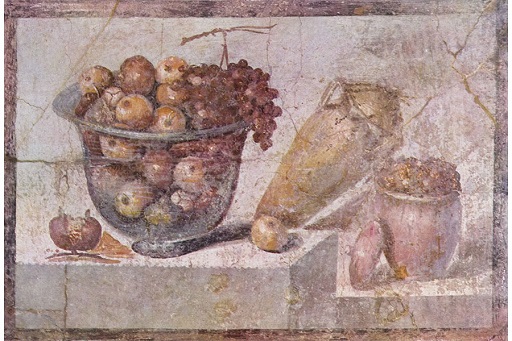2.1 Introducing Pompeii and the Vesuvian sites
The finds at Pompeii and Herculaneum include entire houses, shops, civic and religious buildings, as well as gardens. These provide plentiful evidence on the diet of the Romans in the first century CE. Many houses had toilets in them, which you will discuss in Week 4. The houses are often named after the artefacts, frescos or mosaics found in them. One of them is called the House of the Surgeon (VI 1, 9. 10.23) because an excavation on 6 April 1771 revealed a large collection of medical tools in one room of the house. Further information about medical tools will be given in Week 6.
Wealthy home owners at Pompeii and Herculaneum decorated their houses with mosaics and frescoes. Several of these depict food, as in the case of the fruit bowl shown in Figure 5. Larger than life-size, it comes from the house of Julia Felix (II.4.10), a wealthy resident who renovated her house after an earthquake in 62 CE. The fresco shows a glass fruit bowl filled with fruits, including pomegranates, grapes, and apples, a wine jar, as well as another pot. Another fresco from the same housing complex depicts a bowl of eggs, several hanging birds and cooking implements (see Figure 14 in this week’s summary).

People with less disposable income could eat in one of the numerous eateries and bars at Pompeii and Herculaneum (thermopolia). There, food was kept in large jars (dolia). One such bar advertises its wares as follows:
You can drink here for one as, if you give two, you will drink better, if you give four, you will drink Falernian.
One as would probably be around the price of a loaf of bread. Falernian was a very expensive type of wine, named after Mount Falernus (on the border between Latium and Campania), where the grapes used in its production were grown. You will return to this wine, and wine more generally in the section Ancient tonics: antidotes.
Some dolia found at the Vesuvian sites still contain remains of food that can be analysed with modern archaeo-botanical techniques. For instance, when archaeologists analysed the thick organic deposit in a dolium found in the Villa Vesuvio near Pompeii, they discovered that it had held walnuts, peaches, and a complex mixture made of plant and animal substances. Archaeo-botanist Marina Ciaraldi suggests that the mixture might have been an ancient remedy, and more specifically the Mithridatic antidote, named after King Mithridates of Pontus (again, see Ancient tonics: antidotes). Unfortunately, archaeo-botanical analyses of this type are rarely conducted because they are quite expensive.
You will return to Pompeii and Herculaneum next week, when you look at the sewers which are a further source of information when studying ancient diets.
